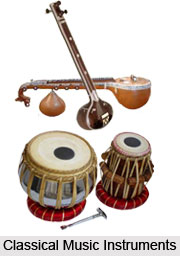 Composition is an important element of Indian classical music. A musical composition portrays a concrete picture of not only the raaga but also presents the emotions imagined by the composer, eloquently. Composition in Carnatic music is varied and is thus a beautiful combination of timber, music and indeed a high flown poetry
Composition is an important element of Indian classical music. A musical composition portrays a concrete picture of not only the raaga but also presents the emotions imagined by the composer, eloquently. Composition in Carnatic music is varied and is thus a beautiful combination of timber, music and indeed a high flown poetry
Carnatic music is rich in compositions. There are a number of compositions in Carnatic music encompassing varied raagas, talas, languages and involving diverse styles and are composed by great philosophers, saints, historians and poets of different periods. Not only to offer a rich facet to this particular genre of music, composition in Carnatic music has manifold roles. Since the theme of Carnatic music is mostly devotional, composition acts as a vehicle to that path of devotion. Amidst its lyrical aspects, compositions in Carnatic music stand as the poetic embodiment of the sentiment of the composer. Composition in Carnatic music often serves as the models for the structure of a raga. Knowledge of these compositions therefore leads to a rather methodical understanding of the structure of ragas whilst unfolding their immense artistic theories. The physical structure of different compositions in Carnatic music ideally demonstrates a very interesting study of literary beauties.
The variety and complexity found in Carnatic compositions is indeed awe-inspiring. Carnatic composition mainly has two elements, one is the musical element and the other one is that which is being conveyed in the composition. Each composition of the Carnatic music unfolds the personality and imagination of the composer hence words are important in the composition of the Carnatic music.
There are many Forms of compositions in Carnatic music. However, the most common and significant forms in Carnatic music are the Varnam and the Kriti. Varnam is a particular type of compositions in the Carnatic music repertoire. Vanram is a relatively long piece and can actually range from thirty minutes. This particular composition in Carnatic music is further embellished by its two popular forms, like the Taana varnam and the Pada varnam. Varnam in Carnatic music highlights everything important about a raaga. Also reckoned as the sanchaaraas of a raga, varnam includes every aspect of raaga like which notes to stress, how to approach a certain note, classical and characteristic phrases of a raga and even the scale of the raga. Kriti, another important composition in Carnatic music are also varied in style and structure. It generally consists three units namely, Pallavi, Anupallavi and Charana.
Apart from Varnam and Kriti, Ragamalika is also counted amongst popular forms of composition in Carnatic music. Ragamalika are delightful compositions, where the various segments are set to different Ragas. In the midst of a smooth and melodious flow of music during the transition from one Raga to the next the Ragamalika are sung. However, the choice of Ragas, as well as the order in which the ragas appear in a Ragamalika, is solely grounded on aesthetic considerations.
The varied compositions of Carnatic music further gain an articulate dimension amidst its articulate rendition.




